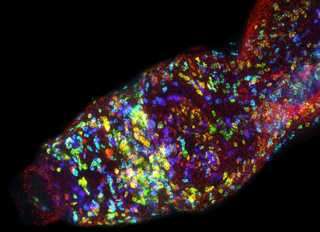Injury triggers stem cell growth in the parasite that causes schistosomiasis

Parasitic flatworms known as schistosomes require a gene called cpb1 in order to survive in mice, according to a new study published in PLOS Pathogens. The study also shows that schistosome stem cells grow in response to injury.
Schistosomes afflict more than 200 million people worldwide and can live in a person's bloodstream for decades. Julie Collins and James Collins of the UT Southwestern Medical Center in Texas have previously shown that schistosome stem cells restore aging tissue, likely aiding the parasite's long-term survival. However, it was unclear whether these stem cells may also help schistosomes recover from injury.
To explore this question, the researchers identified schistosome genes involved in stem cell function and homed in on a gene called cpb1. They used a technique called RNA interference to reduce expression of cpb1 in lab-grown schistosomes and found that this resulted in cell death and organ degeneration in the parasite, as well as dramatic growth of stem cells.
The scientists hypothesized that cell death triggered by loss of cpb1 may have been perceived by the parasite as an injury, triggering stem cell growth to aid tissue repair. Indeed, they observed similar stem cell growth in schistosomes that had been physically injured. The researchers then tested whether cpb1 is important for schistosomes living inside mammalian hosts. They used RNA interference to inhibit expression of cpb1 in schistosomes that were then transplanted into the blood vessels of mice. They found that schistosomes with reduced cpb1 expression were unable to survive inside the mice.
These findings could improve understanding of the role of stem cells in schistosome infection and, in the future, they could help inform development of new treatments. They also demonstrate a new method for studying schistosome gene function in mice that combines RNA interference with a classic schistosome transplant technique.
"Schistosomes are on the receiving end of a variety of insults while living in their human hosts and understanding the parasite's responses to these injuries may suggest new ways to target these worms. What's exciting about these results are that schistosome stem cells appear to be playing a role in responding to injury in the parasite, therefore getting rid of these stem cells may make the worms incapable or repairing damaged tissues."
More information: Collins JNR, Collins JJ III (2016) Tissue Degeneration following Loss ofSchistosoma mansoni cbp1 Is Associated with Increased Stem Cell Proliferation and Parasite Death In Vivo. PLoS Pathog 12(11): e1005963. DOI: 10.1371/journal.ppat.1005963




















